Water Saving and Carbon Reduction (CO2) Synergistic Effect and Their Spatiotemporal Distribution Patterns
Abstract
1. Introduction
1.1. Research Background and Significance
1.2. Research Progress at Domestic and International Levels
2. Synergy Effect Evaluation Methods
2.1. NDDF Model Construction
2.2. Model Parameters and Weight Settings
2.3. Construction of Performance Indicators
2.4. Quantitative Model for Synergistic Effect of Water Saving and Carbon Reduction
2.5. Analysis of Spatial Convergence and Aggregation
2.6. Data Source and Explanation
3. Result Analysis
3.1. Comparison of Individual Water Conservation and Carbon Reduction with Collaborative Performance
3.2. Temporal Evolution of Water Saving and Carbon Reduction Synergistic Effect
3.3. Spatial Distribution Patterns of Water Saving and Carbon Reduction Synergistic Effect
3.4. Convergence of Water Saving and Carbon Reduction Synergistic Effect
3.5. Spatial Aggregation Characteristics of Water Saving and Carbon Reduction Synergistic Effect
4. Discussion
4.1. Why Is “1 + 1 > 2”? Are There Significant Differences Among Different Regions?
4.2. Why Does the Synergistic Effect Exhibit a Spatially Clustered Distribution of “High in the Southeast and Low in the Northwest” Across Different Regions?
- (1)
- Partial Consistency and Significant Exceptions with Water Resource Distribution
- (2)
- High Consistency with Economic Benefit Distribution
4.3. Policy Implications
- (1)
- Formulating regionally differentiated policies based on heterogeneous synergistic effects
- (2)
- Targeting clustered regions as strategic breakthroughs, this study proposes differentiated approaches to enhance synergistic effect.
- (3)
- Focusing on key influencing factors to strengthen the convergence trend of synergistic effect
4.4. Research Prospects
- (1)
- Focus on intra-regional differences and explore effective models of collaborative water saving and carbon reduction efforts in different types of cities. There are significant differences in economic development levels, industrial structures, resource endowments, and environmental carrying capacities across regions, all of which can affect the performance of water saving and carbon reduction initiatives. Therefore, future research could analyze the collaborative effects of water saving and carbon reduction efforts based on different types of cities (such as industrial cities, tourist cities, and agricultural cities) and summarize effective models of collaborative water saving and carbon reducing efforts for different types of cities.
- (2)
- Conduct a systematic analysis of the specific driving factors behind the changes in the synergistic effect of water saving and carbon reduction efforts. The changes in synergistic effects are influenced by a variety of factors, including policy orientation, technological progress, public awareness, and market mechanisms. Future research can identify the key driving factors affecting the changes in synergistic effects through both quantitative and qualitative analyses, and explore how these factors interact with each other to jointly influence the synergistic effect of water saving and carbon reduction efforts.
- (3)
- Compare domestic and international management cases. By comparing successful cases of water saving and carbon reduction efforts both domestically and internationally, summarize the experiences and lessons learned in collaborative management from different countries and regions. Conduct comparative analyses in terms of policy design, implementation process, and effectiveness evaluation, and distill experiences and practices that can be referenced in China, providing new ideas and insights for China’s collaborative management of water saving and carbon reduction efforts.
5. Conclusions
- (1)
- The collaborative performance is significantly better than the individual performance, showing the characteristic of “1 + 1 > 2”.
- (2)
- The temporal evolution of the synergistic effect in most provinces and cities shows a trend of fluctuating upward.
- (3)
- At the national level, the spatial convergence of the synergistic effect shows a “three-stage” change trend, and the convergence changes in different regions have different characteristics.
- (4)
- The spatial agglomeration distribution of the synergistic effect shows the characteristic of being “high in the southeast and low in the northwest.”
Supplementary Materials
Author Contributions
Funding
Data Availability Statement
Acknowledgments
Conflicts of Interest
References
- Liu, Z.; Deng, Z.; Zhu, B.Q.; Ciais, P.; Davis, S.J.; Tan, J.G.; Andrew, R.M.; Boucher, O.; Arous, S.B.; Canadell, J.G.; et al. Global patterns of daily CO2 emissions reductions in the first year of COVID-19. Nat. Geosci. 2022, 15, 615–620. [Google Scholar] [CrossRef]
- Hu, Q.F.; Chen, J.; Wang, H.J.; Su, X.; Zhang, G.R.; Liu, L. Synergistic Development of Water-saving and Energy under the Dual-carbon Goals. China Water Resour. 2024, 15, 39–44. [Google Scholar]
- Jin, Y.; Tang, X.; Feng, C.Y.; Mikael, H. Energy and water conservation synergy in China: 2007–2012. Resour. Conserv. Recycl. 2017, 127, 206–215. [Google Scholar] [CrossRef]
- Ayres, R.U.; Walter, J. The greenhouse effect: Damages costs and abatement. Environ. Resour. Econ. 1991, 1, 237–270. [Google Scholar] [CrossRef]
- Scovronick, N.; Budolfson, M.; Dennig, F.; Errickson, F.; Fleurbaey, M.; Peng, W.; Socolow, R.H.; Spears, D.; Wagner, F. The impact of human health co-benefits on evaluations of global climate policy. Nat. Commun. 2019, 10, 2095. [Google Scholar] [CrossRef]
- Huang, X.Y.; Srikrishnan, V.; Lamontagne, J.; Keller, K.; Peng, W. Effects of global climate mitigation on regional air quality and health. Nat. Sustain. 2023, 6, 1054–1066. [Google Scholar] [CrossRef]
- Wang, P.; Lin, C.K.; Wang, Y. Location-specific co-benefits of carbon emissions reduction from coal-fired power plants in China. Nat. Commun. 2021, 12, 6948. [Google Scholar] [CrossRef]
- Wang, T.Y.; Jiang, Z.; Zhao, B.; Gu, Y.; Liou, K.N.; Kalandiyur, N.; Zhang, D.; Zhu, Y.F. Health co-benefits of achieving sustainable net-zero greenhouse gas emissions in California. Nat. Sustain. 2020, 3, 597–605. [Google Scholar] [CrossRef]
- Tong, D.; Geng, G.N.; Zhang, Q.; Cheng, J.; Qin, X.Y.; Hong, C.P.; He, K.B.; Davis, S.J. Health co-benefits of climate change mitigation depend on strategic power plant retirements and pollution controls. Nat. Clim. Change 2021, 11, 1077–1083. [Google Scholar] [CrossRef]
- Wang, Y.H.; Wen, Z.G.; Lv, X.J.; Tao, Y.A.; Zhu, J.M. The spatial heterogeneity of synergy and trade-off linkages between carbon and air pollutant mitigations in China’s steel industry. J. Clean. Prod. 2023, 418, 138166. [Google Scholar] [CrossRef]
- Tan, Q.; Wen, Z.G.; Chen, J.J. Goal and technology path of CO2 mitigation in China’s cement industry: From the perspective of co-benefit. J. Clean. Prod. 2016, 114, 299–313. [Google Scholar] [CrossRef]
- Shi, X.H.; Huang, Z.N.; Dai, Y.T.; Du, W.Y.; Cheng, J.P. Evaluating emission reduction potential and co-benefits of CO2 and air pollutants from mobile sources: A case study in Shanghai, China. Resour. Conserv. Recycl. 2024, 202, 107347. [Google Scholar] [CrossRef]
- Zhong, L.; Liu, X.S.; Ao, J.F. Spatiotemporal dynamics evaluation of pixel-level gross domestic product, electric power consumption, and carbon emissions in countries along the belt and road. Energy 2022, 239, 121841. [Google Scholar] [CrossRef]
- Yu, S.; Zhang, S.; Zhang, Z.J.; Huo, Y.Z.; Liu, T.K. Evaluation of the synergistic control effect of atmospheric pollutants and greenhouse gases during the 14th Five Year Plan period in Beijing. J. Environ. Sci. 2022, 42, 499–508. [Google Scholar] [CrossRef]
- Tang, X.B.; Zhang, Y.; Cao, L.Z.; Zhang, J.M.; Chen, X.H. The spatiotemporal characteristics and impact mechanism analysis of the synergistic effect of pollution reduction and carbon reduction in China. Environ. Sci. Res. 2022, 35, 2252–2263. [Google Scholar] [CrossRef]
- Zhang, C.; Shi, D.; Li, P.F. Potential benefits of implementing inter provincial carbon emissions trading in China. Financ. Trade Econ. 2017, 38, 93–108. [Google Scholar]
- Steinbuks, J.; Narayanan, B.G. Fossil Fuel Producing Economies Have Greater Potential for Industrial Interfuel Substitution. Energy Econ. 2015, 47, 168–177. [Google Scholar] [CrossRef]
- Wakeel, M.; Chen, B.; Hayat, T.; Alsaedi, A.; Ahmad, B. Energy consumption for water use cycles in different countries: A review. Appl. Energy 2016, 178, 868–885. [Google Scholar] [CrossRef]
- Sowby, R.B.; Capener, A. Reducing carbon emissions through water conservation: An analysis of 10 major U.S. cities. Energy Nexus 2022, 7, 100094. [Google Scholar] [CrossRef]
- Valek, A.M.; Sušnik, J.; Grafakos, S. Quantification of the urban water-energy nexus in México City, México, with an assessment of water-system related carbon emissions. Sci. Total Environ. 2017, 590, 258–268. [Google Scholar] [CrossRef]
- Gu, Y.F.; Dong, Y.N.; Wang, H.T.; Arturo, K.; Xu, J.; Thomas, C.; Li, F.T. Quantification of the water, energy and carbon footprints of wastewater treatment plants in China considering a water−energy nexus perspective. Ecol. Indic. 2016, 60, 402–409. [Google Scholar] [CrossRef]
- Zhao, R.Q.; Yu, J.; Xiao, L.G.; Sun, J.; Luo, H.L.; Yang, W.J.; Chuai, X.W.; Jiao, S.X. Research on Carbon Emissions of Urban Water Systems Based on the Correlation of “Water-Energy-Carbon”. J. Geogr. Sci. 2021, 76, 3119–3134. [Google Scholar]
- Zhu, Y.X. Research on Energy Consumption Evaluation Method for the Whole Process of Social Water Cycle. Master’s Thesis, China Institute of Water Resources and Hydropower Research, Beijing, China, 2017. [Google Scholar]
- Lee, M.; Keller, A.A.; Chiang, P.C.; Den, W.; Wang, H.T.; Hou, C.H.; Wu, J.; Wang, X.; Yan, J.Y. Water-energy nexus for urban water systems: A comparative review on energy intensity and environmental impacts in relation to global water risks. Appl. Energy 2017, 205, 589–601. [Google Scholar] [CrossRef]
- Shrestha, E.; Ahmad, S.; Johnson, W.; Shrestha, P.; Batista, J.R. Carbon footprint of water conveyance versus desalination as alternatives to expand water supply. Desalination 2011, 280, 33–43. [Google Scholar] [CrossRef]
- Yang, W.Q.; Zhao, R.Q.; Zhang, Z.P.; Xiao, L.G.; Cao, L.H.; Wang, S.; Yang, Q.L. Research on Carbon Water Footprint Efficiency of Different Industries in Henan Province. J. Nat. Resour. 2019, 34, 92–103. [Google Scholar]
- Yan, M.Y. Research on China’s Industrial Structure Optimization Based on “Dual Peaks of Water and Carbon”. Master’s Thesis, China University of Petroleum, Beijing, China, 2020. [Google Scholar] [CrossRef]
- Ni, H.Z.; Zhao, J.; Peng, X.J.; Chen, G. Estimating the economic impact of large hydropower projects: A dynamic multi-regional computable general equilibrium analysis. Water Policy 2022, 24, 1343–1365. [Google Scholar] [CrossRef]
- Li, X.; Feng, K.S.; Siu, Y.L.; Hubacek, K. Energy-water nexus of wind power in China: The balancing act between CO2 emissions and water consumption. Energy Policy 2012, 45, 440–448. [Google Scholar] [CrossRef]
- Zhang, C.; Anadon, L.D.; Mo, H.; Zhao, Z.N.; Liu, Z. Water-carbon trade-off in China’s coal power industry. Environ. Sci. Technol. 2014, 48, 11082–11089. [Google Scholar] [CrossRef]
- Feng, K.S.; Hubacek, K.; Siu, Y.L.; Li, X. The energy and water nexus in Chinese electricity production: A hybrid life cycle analysis. Renew. Sustain. Energy Rev. 2014, 39, 342–355. [Google Scholar] [CrossRef]
- Ye, C.X.; Zhong, R.D.; Chen, X.H.; Jin, H.Y. Simulation of the strategic evolution process and interactions between stakeholders in water trading and carbon trading. J. Hydrol. 2023, 616, 128787. [Google Scholar] [CrossRef]
- Tan, Q.L.; Liu, Y.; Zhang, X.P. Stochastic optimization framework of the energy-water-emissions nexus for regional power system planning considering multiple uncertainty. J. Clean. Prod. 2020, 281, 124470. [Google Scholar] [CrossRef]
- Zhao, J.; Duan, J.J.; Han, Y.P.; Gao, F. Correlation between carbon emissions and water consumption in different industries in China: Spatial and temporal distribution characteristics and driving factors. J. Clean. Prod. 2023, 427, 139196. [Google Scholar] [CrossRef]
- Zhang, Q.; Wang, X.Z.; Xu, L.S.; Shen, J.L. Coupling Relationship and Analysis of Steel Process Resources Energy Carbon Emissions. Steel 2020, 55, 103–114. [Google Scholar] [CrossRef]
- Yang, R.P.; Wang, T.; Yang, L.; Li, L.P.; Wang, M. Research on Collaborative Promotion of Water Conservation and Carbon Reduction in the Industrial Sector of the Yangtze River Delta Region. Environ. Sci. Res. 2024, 12, 2622–2631.36. [Google Scholar] [CrossRef]
- Li, L.B.; Hu, J.L. Ecological total-factor energy efficiency of regions in China. Energy Policy 2012, 46, 216–224. [Google Scholar] [CrossRef]
- Lin, B.Q.; Liu, H.X. Is foreign trade conducive to improving energy and environmental efficiency? Taking China’s industrial sector as an example. J. Econ. Res. 2015, 50, 127–141. [Google Scholar]
- Chung, Y.H.; Fare, R.; Grosskopf, S. Productivity and Undesirable Outputs: A Directional Distance Function Approach. J. Environ. Manag. 1997, 51, 229–240. [Google Scholar] [CrossRef]
- Fukuyama, H.; Weber, W.L. A directional slacks-based measure of technical inefficiency. Socio-Econ. Plan. Sci. 2008, 43, 274–287. [Google Scholar] [CrossRef]
- Zhang, N.; Choi, Y. Total-factor carbon emission performance of fossil fuel power plants in China: A metafrontier non-radial Malmquist index analysis. Energy Econ. 2013, 40, 549–559. [Google Scholar] [CrossRef]
- Zhou, P.; Ang, B.W.; Wang, H. Energy and CO2 Emission Performance in Electricity Generation: A Non-radial Directional Distance Function Approach. Eur. J. Oper. Res. 2012, 221, 625–635. [Google Scholar] [CrossRef]
- Tian, Y.; Lin, Z.J. Coupling and Coordination of Agricultural Carbon Emission Efficiency and Economic Growth in Chinese Provinces. China Popul. Resour. Environ. 2022, 32, 13–22. [Google Scholar]
- Zhang, J.; Zhang, Y. Re estimation of China’s capital stock K. Econ. Res. J. 2003, 7, 35–43+90. [Google Scholar]
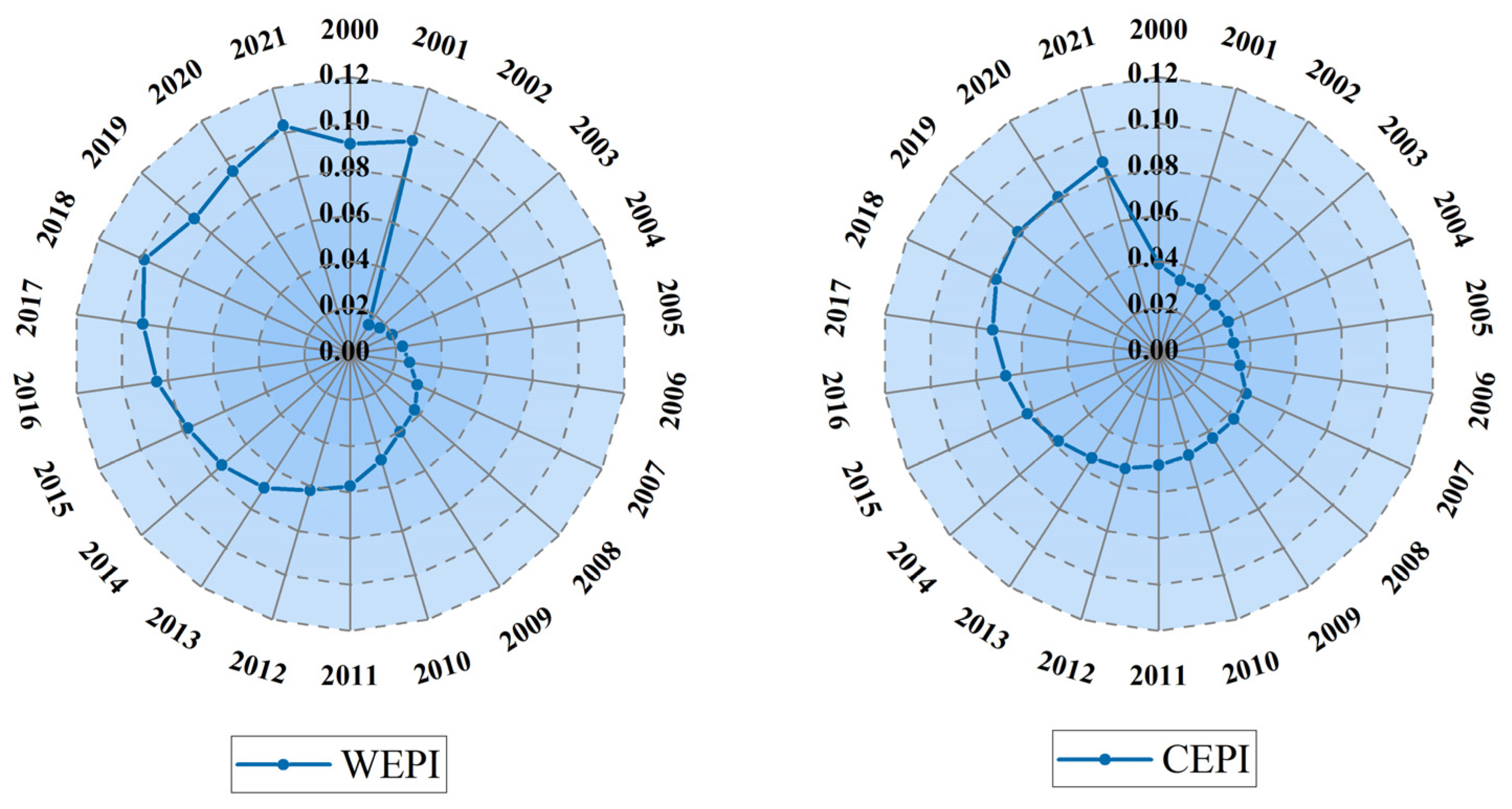
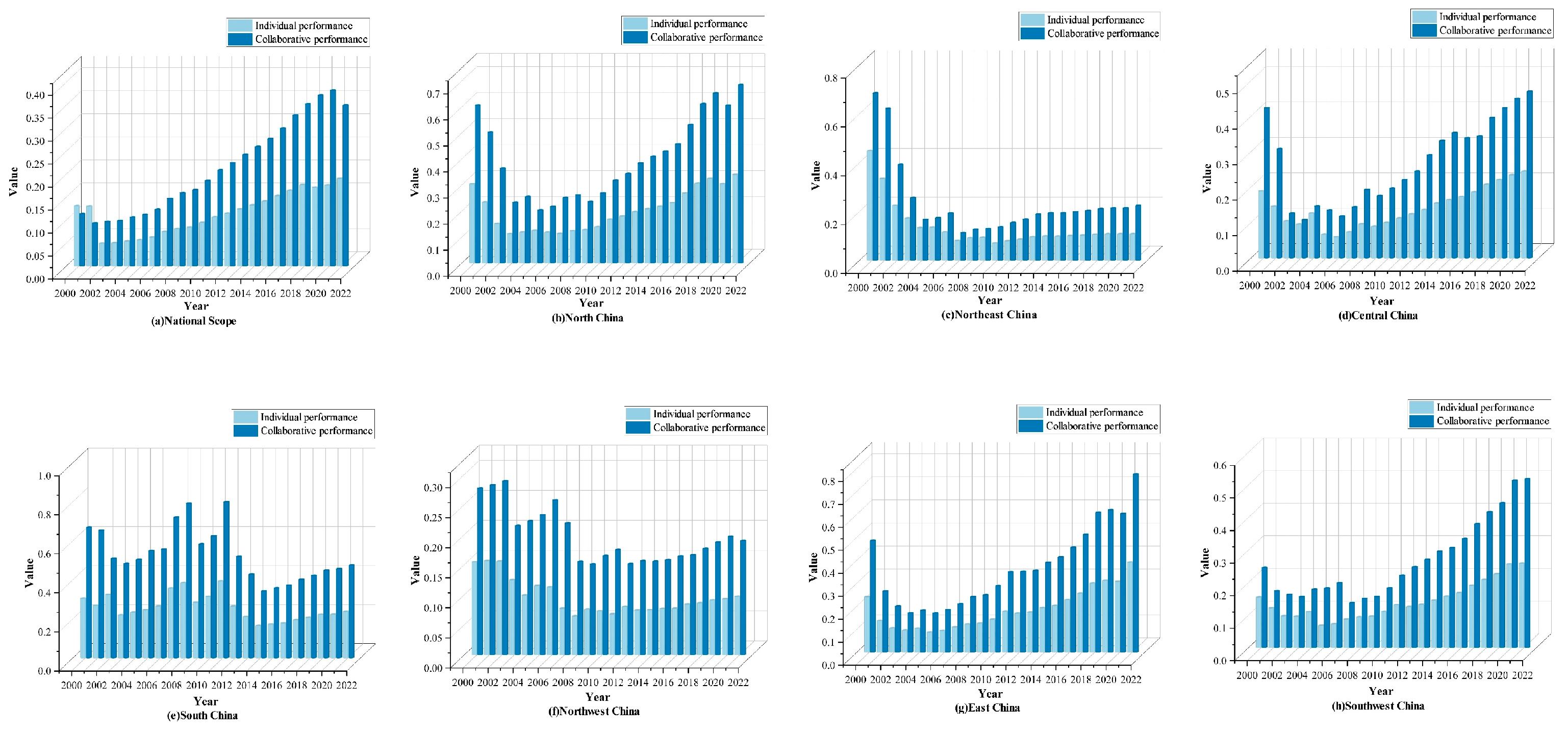
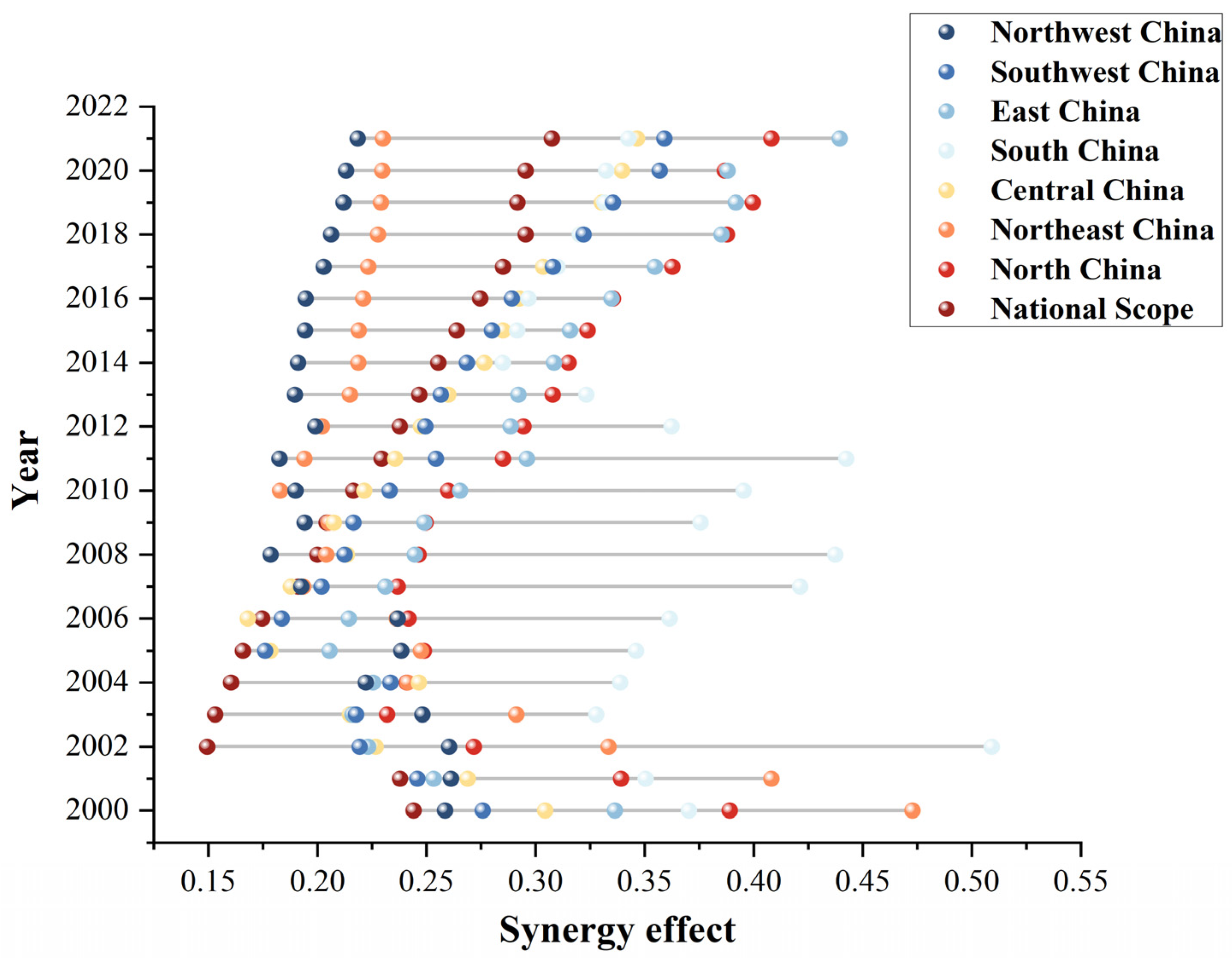
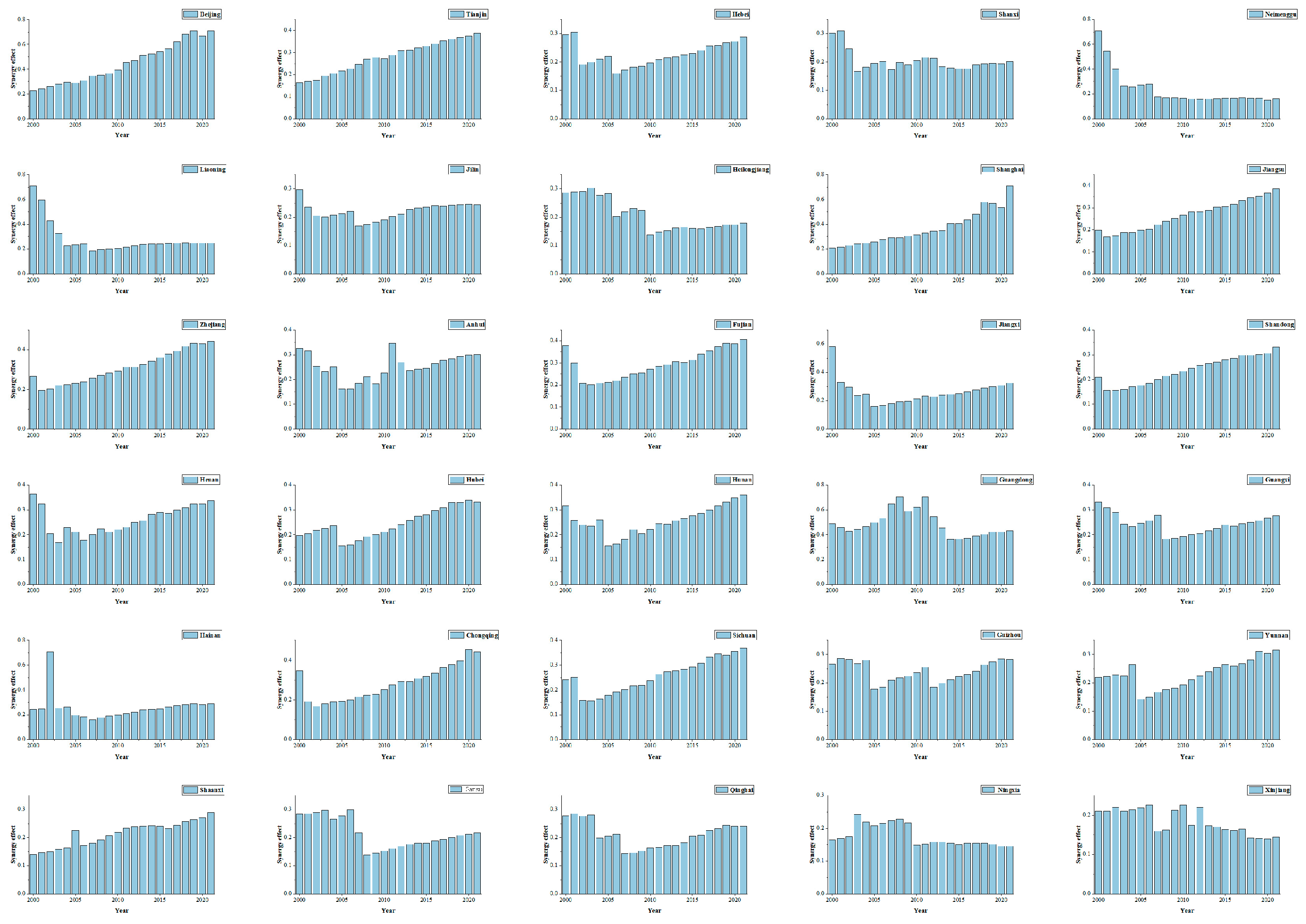
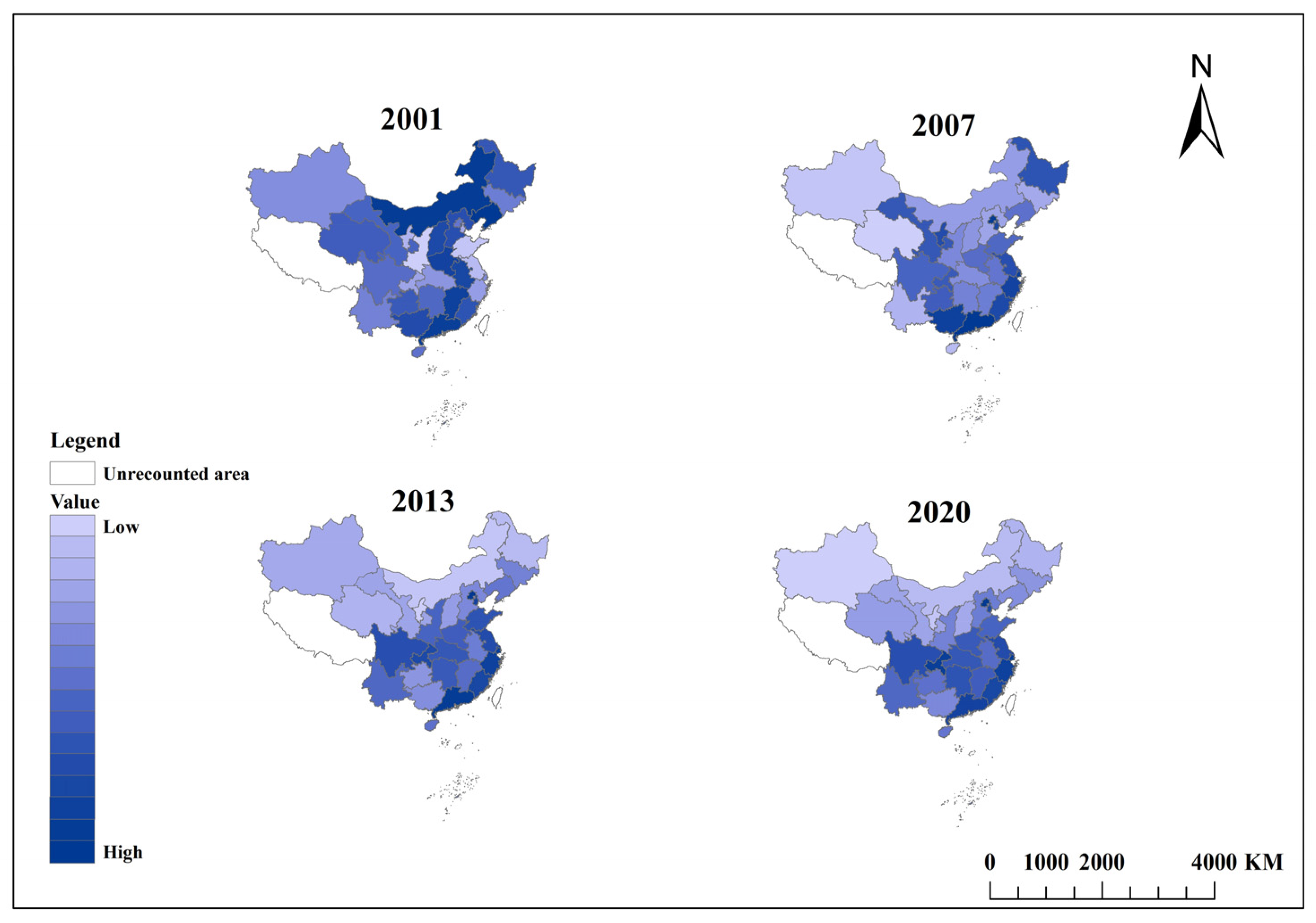
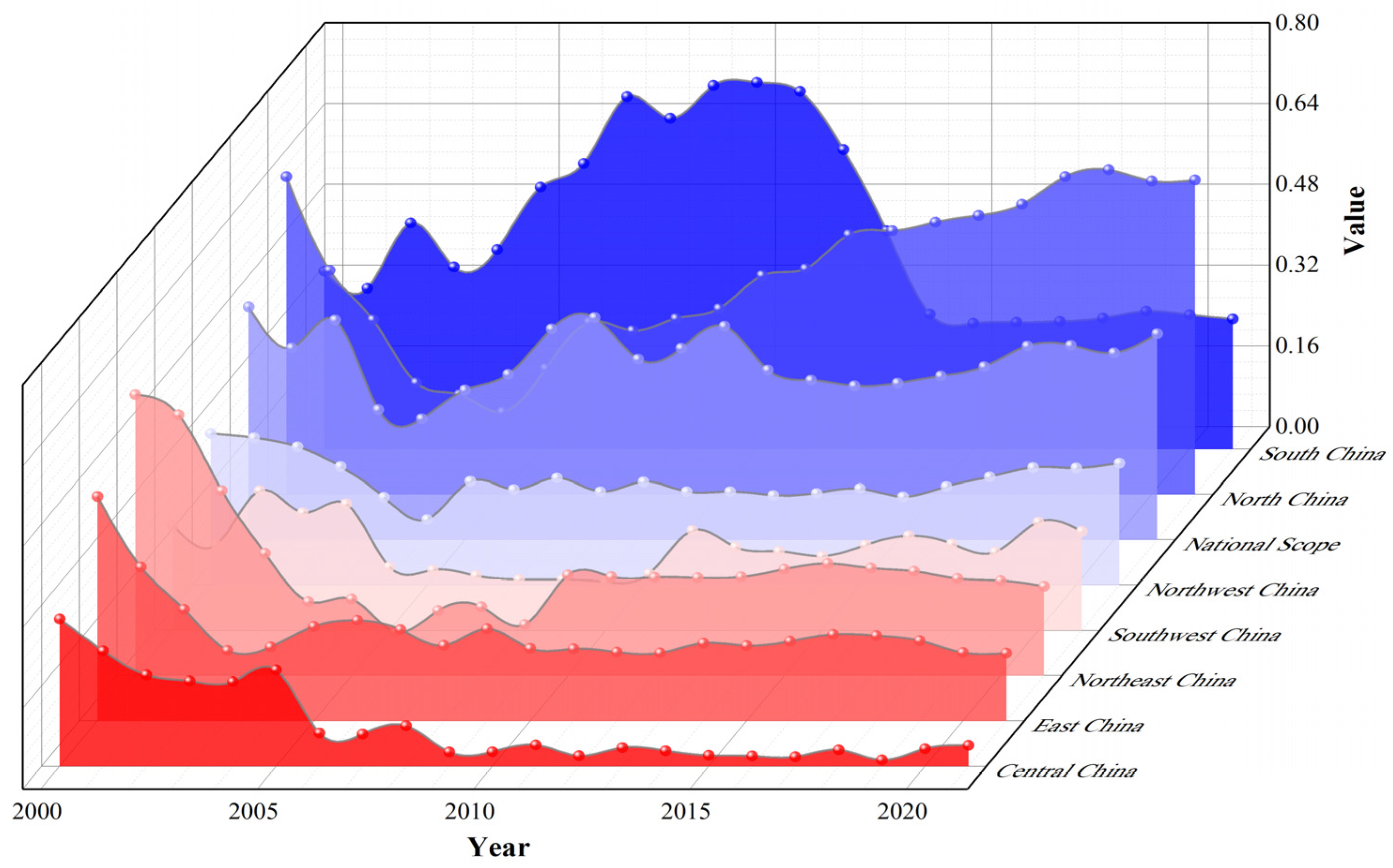

Disclaimer/Publisher’s Note: The statements, opinions and data contained in all publications are solely those of the individual author(s) and contributor(s) and not of MDPI and/or the editor(s). MDPI and/or the editor(s) disclaim responsibility for any injury to people or property resulting from any ideas, methods, instructions or products referred to in the content. |
© 2025 by the authors. Licensee MDPI, Basel, Switzerland. This article is an open access article distributed under the terms and conditions of the Creative Commons Attribution (CC BY) license (https://creativecommons.org/licenses/by/4.0/).
Share and Cite
Zhao, J.; Li, H.; Liu, Z.; Jiang, Y.; Mu, W. Water Saving and Carbon Reduction (CO2) Synergistic Effect and Their Spatiotemporal Distribution Patterns. Water 2025, 17, 1847. https://doi.org/10.3390/w17131847
Zhao J, Li H, Liu Z, Jiang Y, Mu W. Water Saving and Carbon Reduction (CO2) Synergistic Effect and Their Spatiotemporal Distribution Patterns. Water. 2025; 17(13):1847. https://doi.org/10.3390/w17131847
Chicago/Turabian StyleZhao, Jing, Hanting Li, Zhiying Liu, Yaoqing Jiang, and Wenbin Mu. 2025. "Water Saving and Carbon Reduction (CO2) Synergistic Effect and Their Spatiotemporal Distribution Patterns" Water 17, no. 13: 1847. https://doi.org/10.3390/w17131847
APA StyleZhao, J., Li, H., Liu, Z., Jiang, Y., & Mu, W. (2025). Water Saving and Carbon Reduction (CO2) Synergistic Effect and Their Spatiotemporal Distribution Patterns. Water, 17(13), 1847. https://doi.org/10.3390/w17131847





